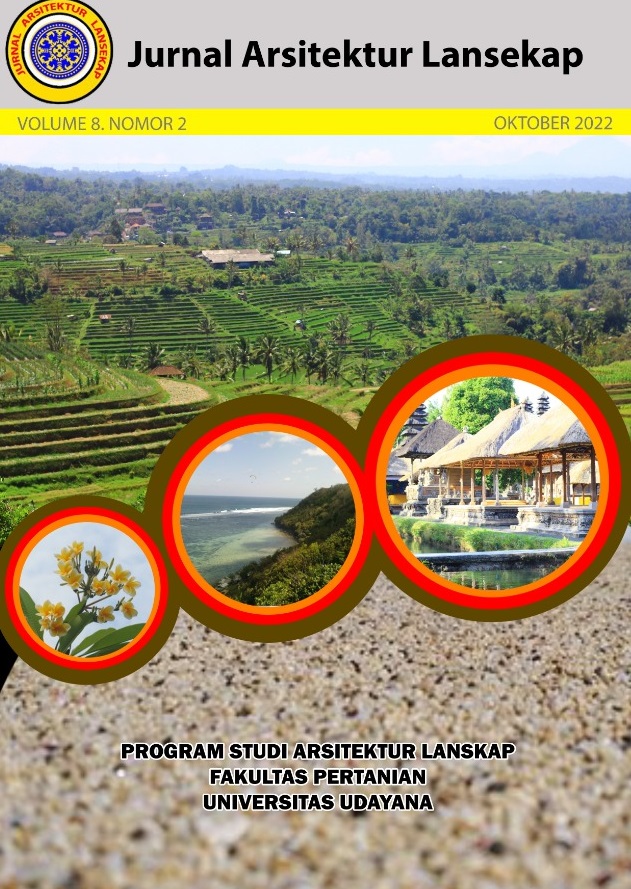Perencanaan Taman Islami Berbasis EDEN (Educational-Dynamical-Ecological-Natural) di Pondok Pesantren Tahfidz Qur’an Dewan Dakwah Lampung
Abstract
Islamic Garden Planning Based on EDEN (Educational-Dynamical-Ecological-Natural) in Pondok Pesantren Tahfidz Qur’an Dewan Dakwah Lampung. Pondok Pesantren Tahfidz Qu’an Dewan Dakwah Lampung is one of the centers of religious education in Kecamatan Kemiling, Bandar Lampung. As an educational area in a strategic region, PPTQ Dewan Dakwah Lampung has the potential to make Bandar Lampung even more advanced. Reciprocity between the government and residents is needed in structuring the PPTQ Dewan Dakwah Lampung related to optimization the land use. The research aims to plan a landscape that can create a quality place to support activities and fulfill user needs. This research used a survey and descriptive qualitative methods. The data were collected through field observation, interview, and literature study, for further were analyzed refers to the complete design process. The research results direct the landscape to an EDEN-based concept (Educational-Dynamical-Ecological-Natural) included in Islamic Placemaking in EDEN (I-PLAN). The application of the elements presented in the site plan or 3D models is adjusted to the concept of an Islamic Garden. By applying I-PLAN can be a safe and comfortable means of education, contemplation, recreation, and behavior guide for users.
Downloads
References
Göker, P., Çalişkan, S. E., & Bulut, A. B. (2021). The Elements of Landscape in Islamic Garden Design. In S. K. University, Developments in Engineering and Architecture (pp. 89-100). Sofia: St. Kliment Ohridski University Press.
Hasibuan, Syahadat, & Sidabutar. (2020). Perencanaan dan Perancangan Lanskap Taman Maju Bersama Haji Saibun di Kelurahan Jati Padang. Jurnal Infrastruktur, 6(1): 15-24.
Hidayat, H. (2020). Simbolisasi Warna dalam Al-Qur’an. MAGHZA: Jurnal Ilmu Al-Qur’an dan Tafsir, 36-50.
James A. LaGro, J. (2008). Site Analysis: A Contextual Approach to Sustainable Land Planning and Site Design. New Jersey: John Wiley & Sons.
jannah, M., Gunawan, a., & Mugnisjah, W. Q. (2019). Taman Islami Kajian Berdasarkan Alquran dan Hadis. Bogor - Indonesia: IPB Press.
Kemdikbudristek. (2017). Retrieved from Badan Pengembangan dan Pembinaan Bahasa: badanbahasa.kemdikbud.go.id
Loviana, S., Islamuddin, A. M., Damayanti, A., Mahfud, M. K., & Merliza, P. (2020). Etnomatematika Pada Kain Tapis dan Rumah Adat Lampung. Tapis : Jurnal Penelitian Ilmiah, 94-110.
MSU Land Policy Institute. (2016). Definition of Placemaking: Four Different Types. In Placemaking as an Economic Development Tool: A Placemaking Guidebook. Michigan.
Peraturan Daerah Provinsi Lampung . (2019). Peraturan Daerah Provinsi Lampung tentang Perubahan atas Peraturan Daerah Nomor 1 Tahun 2010 tentang Rencana Tata Ruang Wilayah (RTRW) Provinsi Lampung Tahun 2009 sampai dengan Tahun 2029. Retrieved from JDIH Pemerintah Provinsi Lampung: https://www.jdih.lampungprov.go.id/
Pusat Pengembangan Kawasan Perkotaan . (2022). Profil Kota Bandar Lampung. Retrieved from PU-Net Basis Data Pusat Pengembangan Kawasan Perkotaan : http://perkotaan.bpiw.pu.go.id/
Reid, G. W. (2001). Grafik Lansekap: Dari Sketsa Konsep Sampai ke Arsiran Penyajian Akhir. Jakarta: Erlangga.
Republik Indonesia. (2014). Undang-undang No. 37 Tahun 2014 tentang Konservasi Tanah dan Air. Jakarta. Retrieved from Undang-undang No. 37 Tahun 2014 tentang Konservasi Tanah dan Air.
Walidaen, N., Utami, N., & Yusiana, L. (2017). Perencanaan Taman Islam pada Lansekap Islamic Center. E-Journal Arsitektur Lanskap Vol.3 No1, 77-86.

This work is licensed under a Creative Commons Attribution-ShareAlike 4.0 International License.
An author who publishes in the Jurnal Arsitektur Lansekap (JAL) agrees to the following terms:
- Author retains the copyright and grants the journal the right of first publication of the work simultaneously licensed under the Creative Commons Attribution-ShareAlike 4.0 License that allows others to share the work with an acknowledgement of the work's authorship and initial publication in this journal
- Author is able to enter into separate, additional contractual arrangements for the non-exclusive distribution of the journal's published version of the work (e.g., post it to an institutional repository or publish it in a book) with the acknowledgement of its initial publication in this journal.
- Author is permitted and encouraged to post his/her work online (e.g., in institutional repositories or on their website) prior to and during the submission process, as it can lead to productive exchanges, as well as earlier and greater citation of the published work (See The Effect of Open Access).
Read more about the Creative Commons Attribution-ShareAlike 4.0 Licence here: https://creativecommons.org/licenses/by-sa/4.0/.







